Airinum is a mask company I first worked with years ago when I reviewed their (at the time) only mask, the Urban Air Mask 2.0. A few months after that review, the company released a more affordable mask that has recently had its second generation released, the Lite Air Mask.
Where the Urban Air Mask and Lite Air Mask form the mid-range and affordable options of Airinum’s line-up, respectively, today’s review is of an entirely different mask. In today’s review, I will look at Airinum’s new top-of-the-line Air Mask Active.
Although it’s fair to say the Air Mask Active is the most premium mask in Airinum’s collection, there’s no denying this mask is much more specialised than the previous two releases. Whereas the Urban Air Mask and Lite Air Mask are meant to be general-use masks, the Air Mask Active (as the name suggests) targets those looking for a mask to use while exercising.
But how does the Air Mask Active hold up as an exercise mask? Perhaps more importantly, can it still be used as a day-to-day mask? In today’s review, I am to answer these questions and more. To do this, I will look at the science behind the mask, such as the certifications and lab testing. After, I will dive into my thoughts and experiences with the mask.
If you have any questions after reading this review, please feel free to contact me in the comments below. I will do my best to reply to all comments. If you’ve tried the Airinum Air Mask Active yourself, I would love to hear about your experiences too! With that said, let’s dive into the review!
Subscribe to BreatheSafeAir
Air pollution is a silent killer that affects millions of people worldwide. Start protecting yourself today.
This post contains affiliate links. For more information, please refer to my affiliate disclaimer. I was sent a product for review, but the article is not sponsored. All opinions expressed in this post are my honest thoughts. I only recommend products that I genuinely believe in.
Information on this blog is for informational purposes only. Readers are encouraged to confirm the information herein with other sources. Furthermore, this information is not intended to replace medical advice from professionals. This website assumes no responsibility for the accuracy of the information, and information is subject to change without notice. Devices mentioned on this website are not medical devices and do not guarantee protection.
Filtration & Certifications

Note: the certifications and lab tests I reference in this section can be found here. I used the Airinum Air Mask Active with the Air Filter Opti. While Airinum offers other filters, this is the only KN95-certified filter.
When it comes to third-party lab tests and certifications, Airinum has been thorough. Regarding non-certification tests, the Air Mask Active has undergone two tests from Nelson Labs for bacterial filtration efficiency (BFE) and viral filtration efficiency (VFE). These tests make up two-thirds of the mask testing ‘trifecta’, with the third test being particle filtration efficiency (PFE).
While BFE and VFE tests can provide important insights into the expected performance of a mask or filter media, PFE tests are more important – especially when they are carried out according to more challenging standards. In the case of the Air Mask Active, the mask is certified KN95 as per GB2626:2019. As part of this standard, the Air Mask Active underwent PFE testing by the laboratory.
Below is a quick overview of the tests performed on the Airinum mask and the certifications it holds:
Certifications:
- KN95 (including PFE, breathability, total inward leakage, and more)
Other tests:
- BFE (bacterial filtration efficiency) by Nelson Labs
- VFE (viral filtration efficiency) by Nelson Labs
Although it’s nice to see the extra testing by Nelson Labs, the most critical testing was carried out by the Jiangsu Quality Supervision and Inspection Center for Special Safety Protection Products to certify the Air Mask Active as KN95; therefore, I will primarily be focusing on these results in this section.
However, before we get to that, what exactly does KN95 mean? Well, I recommend reading this article which compared KN95 to N95, FFP2, KF94, and more. Generally speaking, though, KN95 is roughly similar to N95. The testing conditions are very similar for both standards, with the biggest differences coming down to fit (N95s must have headbands as opposed to earloops).
KN95 is a self-regulated standard, meaning no regulatory agency ensures that manufacturers meet the standard. In other words, unlike most other respirator and mask testing standards, no central body oversees masks certified to the standard. For this reason, it’s essential always to ensure that the laboratory that approves the mask as KN95 is accredited by CNAS (China National Accreditation for Conformity Assessment).

Luckily, Jiangsu Quality Supervision and Inspection Center for Special Safety Protection Products, a CNAS-accredited laboratory, performed testing on the Air Mask Active. This can be seen by the stamp (highlighted by the purple box) above.
The KN95 certification is the most important to discuss regarding the mask’s overall performance. Not only is the particle filtration standard significantly more challenging than the bacterial and viral filtration efficiency tests the Air Mask Active underwent, but it’s also the most thorough test as it’s a complete respirator standard as opposed to merely a filtration efficiency test.
While GB2626:2019 requires a range of tests to be carried out on all respirators, the three we will be looking at are:
- Particle filtration efficiency
- Pressure drop (breathability)
- Total inward leakage
Particle Filtration Efficiency
Firstly, and most importantly for many people, is the PFE testing. For a mask to be certified KN95, it must have > 95% filtration against NaCl particles. Both untreated and treated (worst-case) masks are tested; in total, 28 samples of the Air Mask Active underwent filtration testing. All samples achieved > 95% filtration.
Among the samples, the worst-performing mask sample had 95.4% filtration efficiency. On average, most samples sat at around 95.8% – 96% filtration efficiency. While this result isn’t as high as you would see on most disposable N95s (Most surpass the required 95% filtration efficiency) or other reusable cloth masks such as Cambridge Mask or Vogmask, it’s still a good performance and shows the Air Mask Active has achieved its KN95 certification.
Bacterial Filtration Efficiency
While many people refer to BFE test results to judge how well their mask will perform against bacterial particles, this test is far less important than PFE testing. An article by the CDC highlights this by stating ‘Whether the particle is “living” or “infectious” plays no role in how well it will be collected by a filter. Once a particle is collected, it will remain attached by electrostatic, and van der Waals’ forces and will not easily migrate. Biological organisms have no capacity for moving on their own through a filter.’
Since PFE conditions are far more challenging than ASTM F2101 (the BFE standard used), PFE testing is more representative of a mask’s performance. Not only are the particles far smaller, but the flow rate is higher, and other conditions are tailored to make the testing representative of a ‘worst-case situation’ for the mask’s performance.
That said, more testing is never bad! In BFE testing carried out by Nelson Labs, all five tested samples of the Air Mask Active ≥ 99.9% filtration against bacterial particles at 3.0μm. Impressively, on three of the five samples, no particles were detected as having penetrated the filter media.
Viral Filtration Efficiency
Similarly to BFE, viral filtration efficiency is not a particularly important standard for the above reasons. Furthermore, VFE tests are carried out according to a modified version of ASTM F2101 (the test used for BFE). This means the test conditions are identical, and only the challenge particle differs. Therefore, BFE and VFE tests tend to provide very similar results.
However, for anyone curious as to how the Air Mask Active performs with viral challenge particles, the results are even better than its BFE. Across all five samples, no viral particles were detected as penetrating the filter media. Since a result of 100% filtration is impossible, the VFE of the Air Mask Active is ≥ 99.9%.
Breathability
Also important is the pressure drop, which represents the breathability of a mask. The KN95 standard GB2626:2019 requires the inhalation resistance to be ≤ 250 Pa, while the exhalation resistance must be ≤ 150 Pa. The Air Mask Active had around 120 Pa of inhalation resistance and 47 Pa of exhalation resistance across three samples. This significant difference between inhalation and exhalation resistance is due to a valve on the mask.
It is worth noting that Airinum includes a valve deactivator with purchases. If you’re in a situation where two-way filtration is needed, this cover should be inserted to prevent unfiltered air from escaping the mask. Unfortunately, using the valve cover will lead to greater exhalation resistance.
Overall, breathability on the Air Mask Active is similar to a standard N95 respirator. If you’ve tried a range of these respirators, you’ll already understand the breathability to expect from the Airinum Mask.
Anti-Viral & Anti-Bacterial Coating
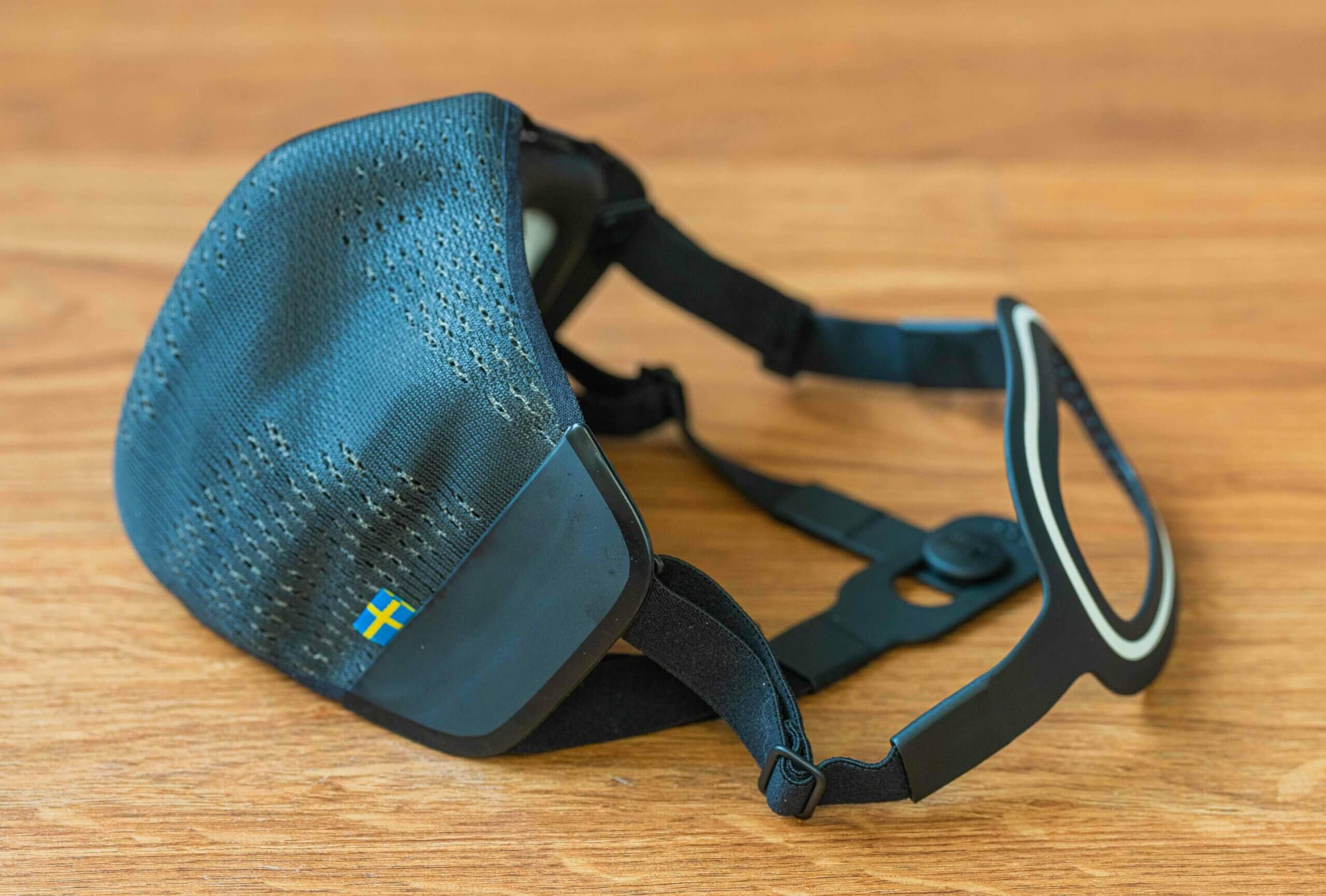
If you look at the standards page for the Air Mask Active, you will notice three more test reports are available to download. Three different third-party laboratories performed these tests to determine the surface activity of viral and bacterial particles on the mask.
The outer shell of the Air Mask Active is coated with Polygiene’s ViralOff, a coating designed to reduce viral and bacterial activity on the mask. Across the three tests, the Air Mask Active was tested against a range of particles, including SARS-CoV-2 (2019, Italy strain), Staphylococcus, E. coli, and more.
The viral test showed a 99.99% reduction in particles after 2 hours, while the two bacterial tests showed a bacterial reduction of > 99% (Staphylococcus, E. coli, Candida albicans) and ≥ 99.97% (S. aureus) over 18 and 24 hours respectively.
While this coating won’t provide added filtration to the mask, it does mean the mask can slowly reduce viral and bacterial concentrations on its surface. This is great for mask reuse as it means the mask will be largely virus and bacteria-free in the morning.
Summary
Looking for the TLDR? Below is a table summarising the Airinum Air Mask Active filtration performance against the different particle types.
| Test Type | Standard | Efficiency |
|---|---|---|
| PFE | GB2626:2019 | ≥ 95.8% |
| BFE | ASTM F2101 | ≥ 99.9% |
| VFE | Modified ASTM F2101 | ≥ 99.9% |
Overall, the Air Mask Active has sufficient testing to show its efficacy against a range of particles. While its PFE performance is significantly lower than its BFE and VFE performance, this is expected due to the more difficult testing conditions of GB2626:2019. Furthermore, with ≥ 95.8%, the Air Mask Active exceeds the filtration requirement for KN95 masks.
Buy the Airinum Air Mask Active
Fit

Although we spend a lot of time discussing the filtration of a mask, the fit is equally as important, if not more so. Where filtration shows the theoretical performance of a mask, fit dictates whether that performance is relevant.
Before discussing the fit of the Airinum Air Mask Active, I want to make a disclaimer. Everyone has a different face, and no mask will fit everyone the same. As such, everything discussed in this section is based on my experiences and may not apply entirely or at all to you. With that out of the way, let’s get started!
Fitting the Air Mask Active is straightforward. Firstly, you’ll want to place the mask around your neck and attach the two neck straps behind your head. If the bottom strap doesn’t secure the mask to your face, you’ll want to tighten it until the mask can sit firmly against your face, even without the top headband supporting it.

Once you’ve found this firm fit, you can pull the top headband over your head. Located in the centre of this headband is a plastic loop with one spiked side for grip – this surface should be turned in, meaning it should be sitting against your hair. If fitted correctly, this loop should sit above the crown of your head.
As with the lower strap, the top strap can be fully adjusted from both ends. This leaves a lot of room for customising the fit to suit your head and face exactly.
Sizes
The Air Mask Active currently comes in only one size, M/L. This mask is suggested for people above 132 lbs (60kg) by Airinum, and I believe this suggestion may be a bit off. I am around 68kg, and while I have a small face, the mask feels quite large. Although the mask does fit well (more on that soon!), it feels somewhat cumbersome due to its size.
The bottom of the mask sits just under my eyes; while it doesn’t obscure my vision, it’s always visible. Luckily, despite the mask being seemingly too large, the mask seals surprisingly well. Why is this? Well, it’s likely a combination of the headbands and the Air Mask Active’s other secret weapon – an elastomeric-like seal.
Seal

If you’ve never worn an elastomeric mask such as an Envo Mask, ElastoMaskPro, or Flo Mask, you might not know what exactly I mean. However, these masks rely on silicone or plastic and use seals moulded to a face shape. Together, these factors mean these masks almost always provide a better fit than cloth masks and disposable respirators.
Now, the Air Mask Active is not an elastomeric respirator and doesn’t provide quite as good of a seal. However, compared to other ‘biking’ or ‘sports’ masks, such as the R-Pur Nano Light, the Air Mask Active provides a better seal. Compared to more standard reusable masks such as Cambridge Mask, Vogmask, or even Airinums Urban Air Mask 2.0, the Air Mask Active is a big improvement in my experience.
That isn’t to say it seals perfectly every time. The first few times I wore this mask, I thought it fit very poorly. No matter how much I adjusted the mask, the first three or four times I donned it, I couldn’t fully seal it around my nose. However, after bending the mask frame slightly (I believe it got bent out of shape) and sitting the mask higher on my face, it felt like an entirely different experience.
Not only does the mask seal well, but I seldom detect any leaks. My glasses wouldn’t fog, and around my entire face, the plastic seal seemed to make good contact with my face. Overall, after wearing the mask for a few weeks after this finding, I was impressed with how well it fits.
Sports/Active Use
As the name suggests, the Air Mask Active is designed for sports and active lifestyles. In fact, if the imagery on Airinum’s website is anything to be believed, it’s the perfect mask for urban bikers!
While I can’t comment on how well the mask stays secured while biking, it did a commendable job on my 5km runs. Even when I made significant head movements (such as looking left and right before crossing the road), the mask stayed in place and leak-free – 95% of the time.
If I had to do extreme head movements such as quickly looking behind me, looking up, or sneezing, the mask would get dislodged from time to time, but this was usually temporary, and it would fit itself back into place. While the fit wasn’t perfect while active, no mask that I’ve tried is.
Based on this, I am surprised to say the Airinum Air Mask Active may become my exercise mask – at least based on fit alone. It seals well, is secure, and usually doesn’t move or leak.
KN95 Fit Testing

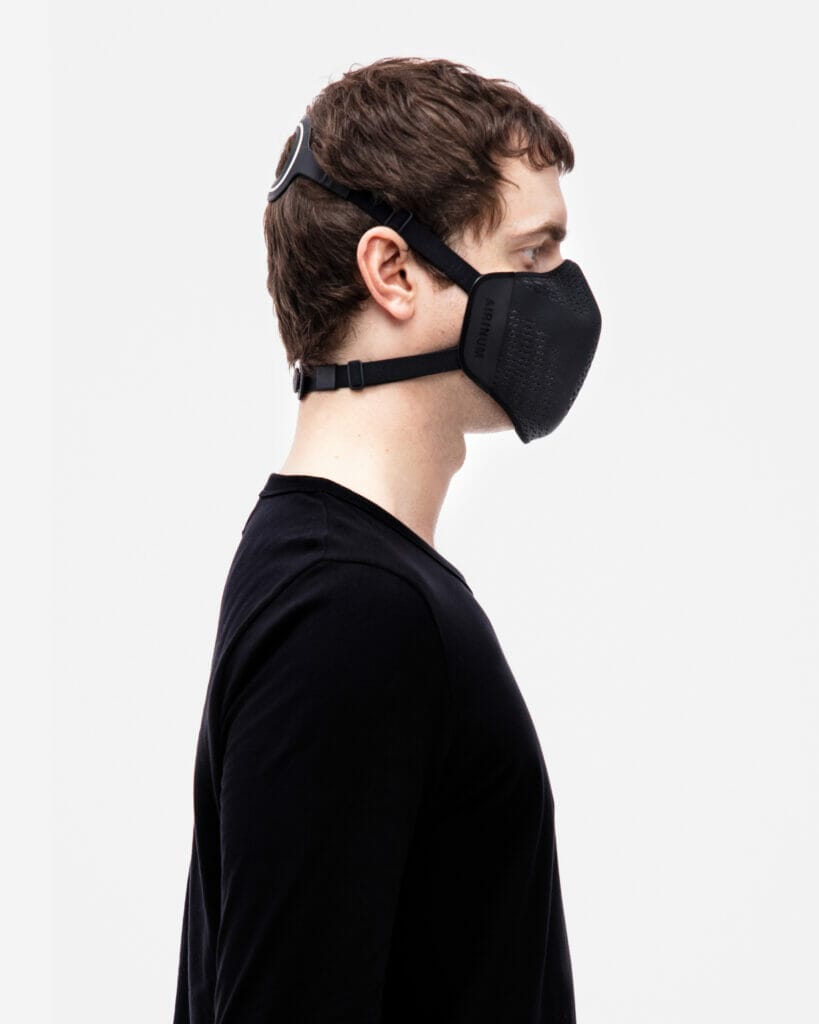
So far, all my discussions regarding fit have been observational. However, Airinum has some formal fit testing from its KN95 certification, which requires a TIL (total inward leakage) test to be carried out on various subjects performing different actions.
Ten different human subjects must wear the mask while performing five basic actions. These actions are remaining static (wearing the mask and not moving), turning their head from side to side, up and down, taking, and then becoming static again.
Across these 50 actions (10 people each performing five actions), the leakage of at least 46 tests can not exceed 11%. Furthermore, the leakage of eight subjects out of ten can not exceed an average of 8% across the five actions they must carry out.
The Air Mask Active passed these tests, with 47/50 tests remaining under the required 11% leakage. Furthermore, nine subjects passed the test, and only one person exceeded the mean of 8%.
What does this mean in application? Well, the Airinum Air Mask Active generally provides minimal leakage across a range of subjects. It is worth noting, however, that these tests are carried out on a board of subjects from the local demographic. Since a Chinese lab carried out these tests, it’s possible and even likely that the mask will fit you differently.
Summary
I was pleasantly surprised at how well the Airinum Air Mask Active fit. While the fit wasn’t flawless, and I did get leaks around the bridge of my nose occasionally, it generally performed very well. Leaks were rare and usually occurred during exercise, and the mask was sturdy enough to remain in place and stay well sealed.
The Air Mask Active does not fit as well as a quarter-face respirator such as Envo Mask, but it does fit significantly better than non-elastomeric masks. This puts it in a unique position where it has essentially formed its own niche.
Buy the Airinum Air Mask Active
Comfort

What’s the point of a mask if it’s uncomfortable? Of course, a mask’s primary purpose is to protect you. However, with so many different high-quality masks on the market, there’s no reason to stick with an uncomfortable mask anymore.
The Air Mask Active is a comfortable mask with a couple of caveats. Similar to the fit, the Air Mask Active feels far more akin to an elastomeric respirator than a cloth mask when it comes to comfort. What do I mean? Well, when I wear the Air Mask Active, I feel similar to when I wear a Flo Mask.
This is likely because of two factors; firstly, the mask relies on two (relatively thick) headbands and secondly, the filter media sits a few centimetres from your face rather than against it. Both of these make wearing the Airinum Active Mask feel substantially different from wearing a disposable respirator or cloth mask.
Breathability

Starting from the front, the Air Mask Active sports a breathable mesh filter behind which the filter, valve, and mask frame sit. While the mesh is lightweight and breathable, most breathing resistance comes from the mask’s filter. This makes the emphasising Airinum places on the mesh’s breathability feel somewhat irrelevant.
With that said, the breathability is fine without the valve and good with it. I experience the most discomfort after exhaling as the mask becomes hot and humid and the valve works to minimise this issue by quickly exhausting this uncomfortable air – the issue? A valve shouldn’t be used when two-way filtration is needed.
Luckily, if you are using this mask as an active mask, it’s likely you’re wearing it for pollution protection instead of viral protection. Opening the valve and decreasing exhalation resistance will make the mask significantly more comfortable in these cases.
Seal
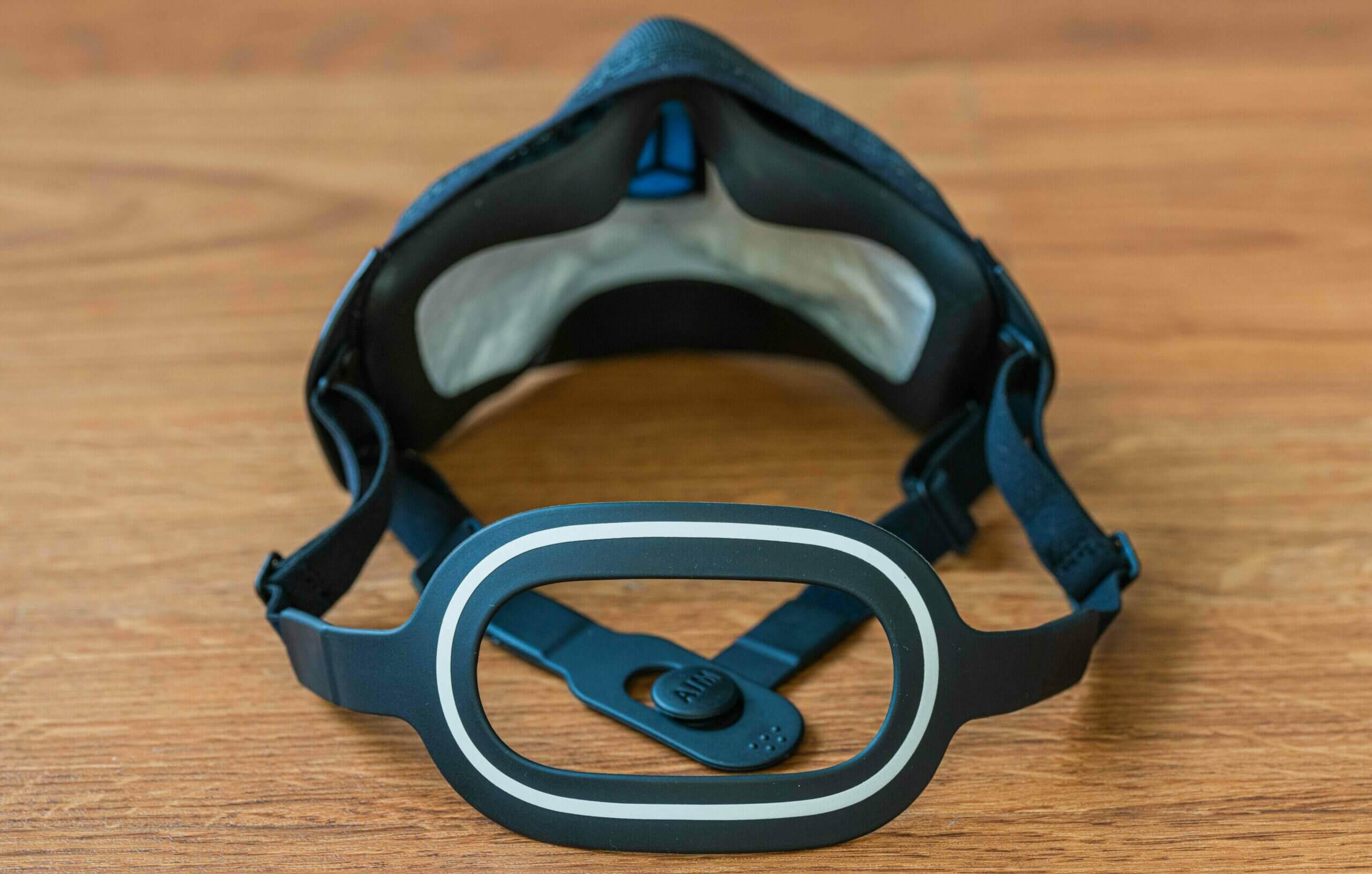
Behind the filter sits the frame of the mask, and this is where the seal is created. The filter is attached to the frame, and every time you replace the filter, you will be replacing the mask’s frame too. The frame is quite rigid and doesn’t seem particularly comfortable at first touch.
Thankfully, this wasn’t the case for the most part, and I found the frame and seal to be generally comfortable. I did find that when the mask was tight, the frame would push into my face near the top of my cheek. While this wasn’t a painful experience, it wasn’t particularly comfortable, and I wish the frame could be adjusted slightly.
The materials used in the frame and seal didn’t cause me any skin irritations, which I found quite surprising. I have very sensitive skin, and usually, I found masks with silicone seals to become uncomfortable after a few hours. Furthermore, my skin tends to stay itchy after removing the mask. With the Air Mask Active, I didn’t have any such issues.
Headbands
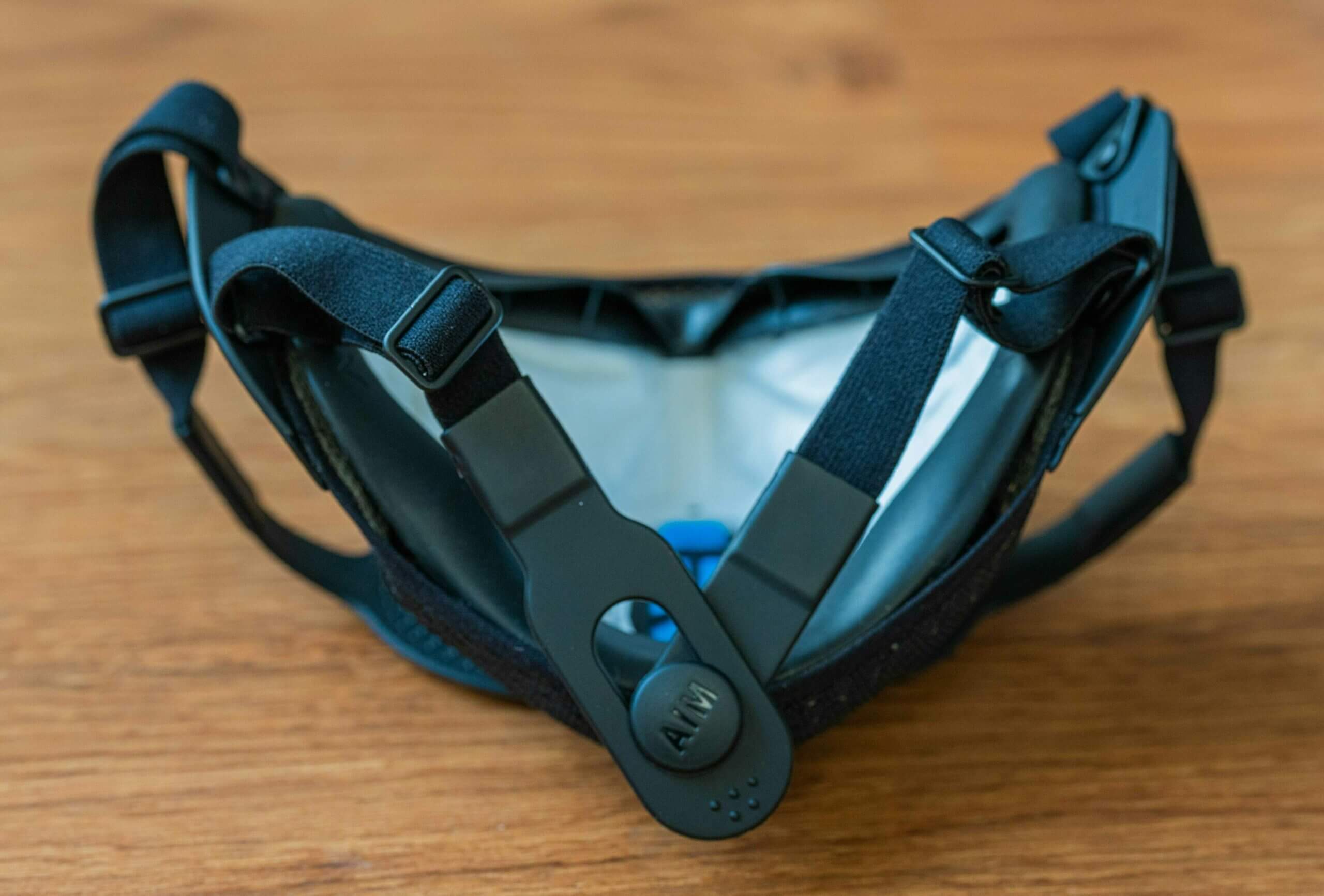
Moving to the back of the mask, we find the Airinum Air Mask Active’s headbands. From my experience, these bands are one of the biggest strengths of this mask’s comfort – they are large and distribute weight very well. Furthermore, the materials are comfortable and wearable for long periods.
Both bands are elastic, and the clasp and halo loop is made from rubber. This rubber is comfortable and was a vast improvement over wearing earloops, which quickly become uncomfortable. I’m very thankful that unlike some masks, such as Stealth Mask, the clasp didn’t dig into my neck and cause discomfort.
Talking & Head Movements
Regarding comfort while talking, the Air Mask Active does a great job. Since the mask filter sits a few centimetres away from my face, it’s easy to talk without the worry of filter collapse or inhalation. Furthermore, there’s ample room in the mask to allow for actions such as sneezing.
There is minor voice muffling, but no worse than disposable respirators such as N95s. I found no serious issue with communication with this mask as, at worst, it will make your voice slightly quiet with slightly more distortion.
Buy the Airinum Air Mask Active
Pricing & Lifespan
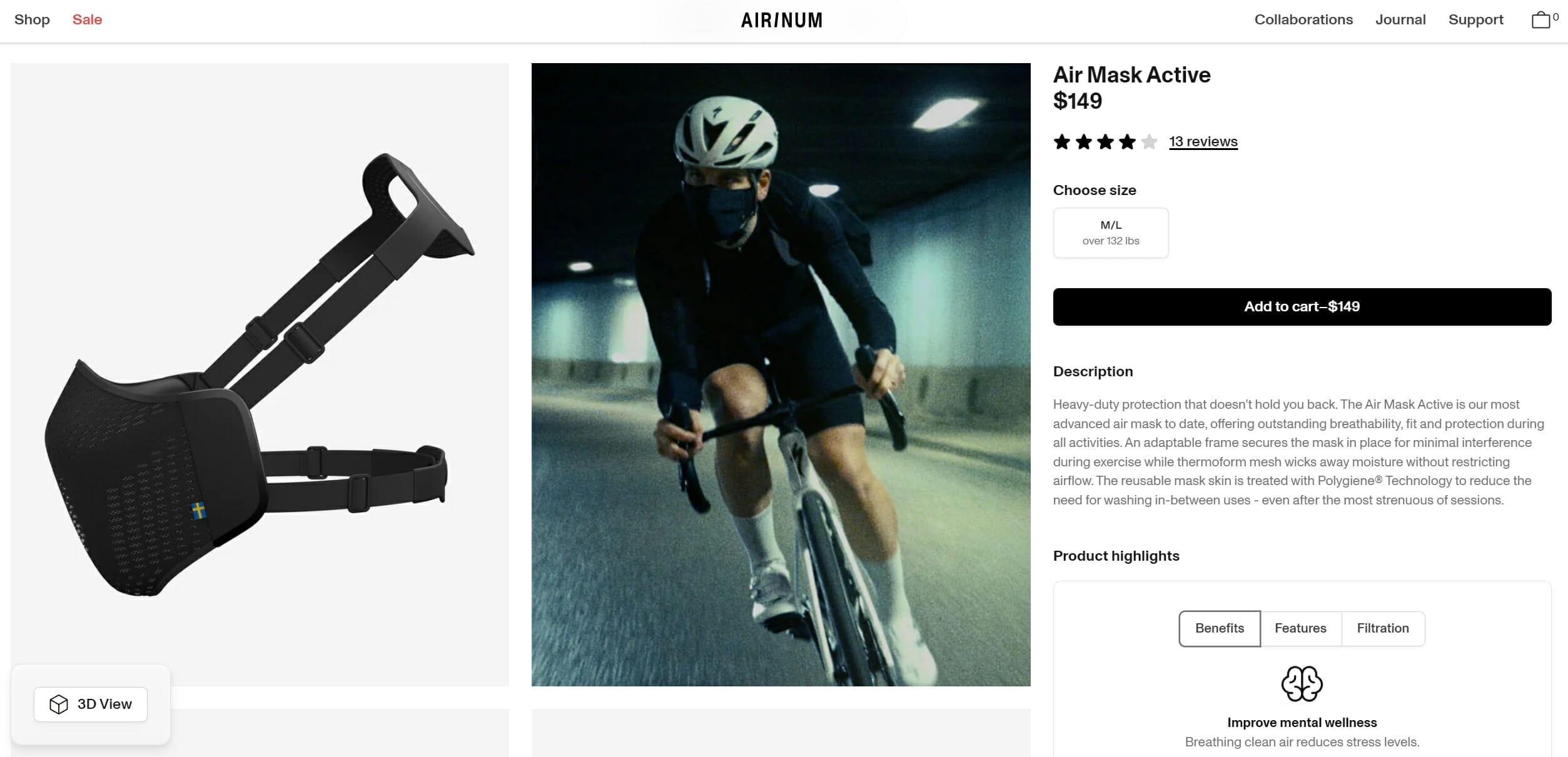
When it comes to the downsides of the Airinum Air Mask Active, there is one glaring above all else – the price. The Air Mask Active is expensive, and there’s no other way to look at that. It’s currently tied with the R-Pur Nano Light for being the most expensive mask I’ve reviewed on this website.
If you’re in the U.S., the Air Mask Active comes in at $150; if you’re in other markets, it may be even more expensive. For example, if I purchased it in New Zealand, I would have paid $250 instead of the $235 USD equivalent. You should be getting a mask with no flaws at this price range, or at least flaws minor enough to be overlooked.
For perspective, most high-end elastomeric quarter-masks and half-masks cost around $80. These are also expensive products, but they aren’t close to the price of the Air Mask Active. With that said, Airinum has always created premium masks with an emphasis on form alongside functionality.
New filters will cost you $35 (USD) for a 3-pack. If you subscribe to Airinum’s filter replacement service, this price is dropped to $30, meaning filters can cost $10 each at their cheapest. Based on Airinum’s advice, each of these filters should last a fortnight, meaning you are looking at $20-$25 per month.
At this price, the long-term cost of the mask is quite high compared to other competing masks. However, it is noted on the website that filters can last a month – they should just be replaced more frequently for hygiene reasons. What does this mean? Well, suppose you are utilising filters to their maximum. In that case, the Airinum Air Mask Active can come in cheaper or at a similar price to disposable alternatives and some other masks with replaceable filters.
I’ve been using my most recent filter for around three weeks and could use it for another week without issue. However, the filter is beginning to smell a bit, and it no longer feels fresh – I recommend changing the filter every two to three weeks. Therefore, a reasonable ongoing monthly price is $15 – $20.
Furthermore, there is a large price to enter into Airinum’s Air Mask Active system. At the end of the day, I can’t say whether the price is worth it or not because I believe some people will find this mask worth the money while others won’t be able to justify it.
So, who is the Air Mask Active for? Based on the fit and comfort, I believe it’s a good mask for anyone looking for a mask to use while exercising. If you are a biker regularly cycling along polluted roads, a jogger who runs regularly through urban environments, or you like to play soccer on inner city fields, the Air Mask Active is tailored towards those use cases.
Buy the Airinum Air Mask Active
Conclusion

At the end of the day, would I recommend the Air Mask Active? This is quite easy for me to answer – for most people, no. However, some people might find the Air Mask Active the perfect mask. These people are bike and motorcycle commuters and those who need a mask for exercising.
The mask has a lot of strengths – it has an elastomeric-like fit, offers a high level of filtration, stays secured in place well, and is comfortable to wear even after a long period. However, the mask’s price keeps it a relatively niche product only for those who know they need its unique selling points.
In this category, there are a few other masks – one I’ve reviewed on this blog is the R-Pur Nano Light. However, while I enjoyed using the Nano Light, I believe the Air Mask Active is more comfortable and has a better fit – it also looks better as it’s lower profile.
Furthermore, the Air Mask Active has the benefit of being coated in Polygiene’s antimicrobial material. Although this coating won’t instantly deactivate viruses, it’s a nice addition as you can rest assured knowing your mask surface is clean every morning.
Of course, the Air Mask Active isn’t perfect, either. It’s quite large and can somewhat obscure vision when looking down. On top of this, the mask heavily relies on a valve – if you need to deactivate this for whatever reason, breathing resistance is significantly increased. On a sports mask, this isn’t ideal.
However, other than the price, most of my complaints with the Airinum Air Mask Active are minor. If you believe this mask suits your needs (and budget), it’s worth checking out. It may just be the mask you’ve been looking for.
Please comment on this post if you feel I’ve left something unanswered. I do my best to reply to all comments and will do my best to help. If you’ve tried the Air Mask Active yourself and have some thoughts, please also feel free to share – I would love to hear from others who have tried the mask.
Buy the Airinum Air Mask Active
Air Mask Active FAQ
Is the Air Mask Active Certified?
Yes. The Air Mask Active is certified KN95 by a third-party laboratory.
Does the Air Mask Active Have Lab Testing?
Yes. The Air Mask Active has KN95 testing by a CNAS-accredited laboratory. It also has BFE and VFE testing from Nelson Labs.
How Does the Air Mask Active Differ From the Urban Air Mask?
The Air Mask Active is different in almost every way. The mask relies on headbands instead of earloops and uses an elastomeric seal. However, there are far more differences besides these.
Where Can I Buy the Air Mask Active?
You can purchase the Air Mask Active from Airinum’s website.
Have Questions or Comments?
Join the discussion on the BreatheSafeAir Community Forum. Ask any questions you have about air quality or adjacent topics and get quick answers!
Airinum Air Mask Active

The Airinum Air Mask Active is a mask designed for commuters and sports players. The mask features dual-headbands, an exhalation valve, great comfort, and a fantastic seal. However, it's also pricey.
Product Brand: Airinum
3.5
Pros
- Great fit
- Replaceable filters
- Comfortable
- Uses an anti-viral coating
- Stays in place with a secure seal
- Looks sleek
Cons
- Expensive
- Filters can be difficult to replace
- Quite large
- Somewhat time consuming to put on
Really great and thorough article. I truly appreciate the time and effort you out into this as it has helped me with my purchasing decision.
Bless
Damian B
Thank you for the time and thought you put into making this very neutral and objective feeling review. I really appreciate the detail and insight you provided, and it’s helped me decide on which mask to buy before I move to a country in Asia with really bad air pollution, where I’ll be riding a scooter on busy roads every day.
Bella 🙂